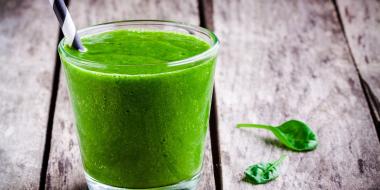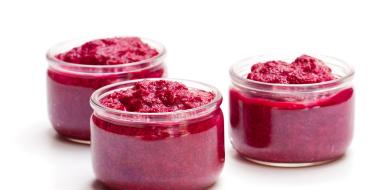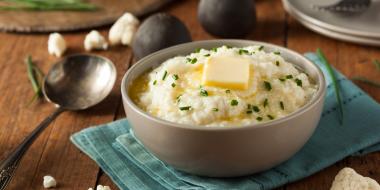There are so many things parents might think about when they begin introducing solid foods. What should I introduce first? Should I go with purées or try baby-led feeding? How do I even get my kid to eat what I offer? While most of these things can be left up to trial and error, personal preference and what works best for your family, the most important thing every family should consider is food safety and how to avoid potential choking hazards when offering new foods.
Before you begin: the basic eating environment
Laying a successful foundation for food safety means setting the scene for healthy eating behaviors before food is even offered. When feeding your child, it is important they are sitting in an upright position with minimal distractions. Eating when in a reclining position or while playing increases the risk of bites of food getting lodged in the throat. Having your child sit in a high chair or at the table also sends the signal that it’s time to eat and can help your child transition from their activity and focus on eating their food.
Once you have your child sitting and ready to eat the real fun begins: the food! The physical act of eating solid food is another motor skill your baby must learn and toddlers continue to refine this skill set (consider how their faces exhibit the evidence smeared with abandon for quite a while!). As your child gains better motor control of their tongue and gets closer to a full set of teeth, they will be better equipped for a wider variety of food shapes, sizes, and textures.
Babies under a year should stick to softer foods that can easily be swallowed with minimal chewing while they are still getting the hang of the whole eating thing. Foods that require a little more chew work or can get jagged edges as they are chewed should be reserved for toddlers with a little more eating practice under their belts.
The trickiest tidbits
Several foods are notoriously tricky for little mouths and pose a choking hazard even under the best of circumstances. Here are the top ten most common choking hazards and how to minimize the risk.
Hot dogs
Hot dogs are nice and smooth and have a unique texture, making it easy for chunks to get lodged in your child’s throat. If you choose to serve hot dogs, be sure to cut them into extra small pieces or thin, noodle-shaped slices for easy eating. Choose hot dogs that are free of nitrates and nitrites (which increase the risk of colon cancer) but be sure to keep them refrigerated to prevent bacterial growth.
Large chunks of meat or cheese
Large pieces of meat or cheese can be tricky for little mouths to chew and break apart before swallowing. Shredding meat and cheese before serving ensures bites are small enough to prevent choking. Or consider other high-protein options like mashed-up soft-cooked beans and lentils.
Whole grapes
The large, round shape of whole grapes perfectly matches the shape of your child’s throat and because they are relatively firm in texture, they can be difficult to chew and may be swallowed prematurely. Cutting grapes in half, quarters, or smaller for younger children makes them easier for your child to handle.
Hard or sticky candy
Hard candies are generally meant to be held in the mouth until they dissolve instead of being chewed. Young children don’t yet have the motor control to hold things in their mouths for extended periods, so hard candies can be prematurely swallowed and get lodged in the throat. Young children also haven’t developed the strength in the muscles at the back of the mouth and in the throat that are necessary to swallow sticky candies and foods like marshmallows. The sugar content alone is enough to recommend avoiding most candy. Just skip these as long as possible!
Globs of nut butter
The internet is full of hilarious videos of dogs trying to swallow peanut butter that’s gotten stuck to the roof of their mouths. This same phenomenon can happen in your child and globs of nut butter can clog things up as it slides and sticks to the back of the throat. It’s best to serve nut butter spread in a very thin layer on bread or toast.
Popcorn
The irregular shape of popcorn means it can easily catch in your child’s throat, and without having developed those strong swallowing muscles, it can be difficult to move the popcorn. Waiting to offer popcorn until you are confident in your child’s swallowing is the safest bet. You can always offer soft, fresh fruit as a snack instead.
Raw vegetables
Raw vegetables tend to have a hard, firm texture, making them difficult to chew and swallow safely without a full set of teeth. Roasting or steaming vegetables until they are very soft makes them much easier for little mouths and teeth to chew.
Apples
Apples are favourites, but raw apple can also be too firm for little chewers with only a few teeth, so shred them first. Baking apple chunks to soften them up and adding a pinch of cinnamon can make for a healthy sweet treat.
Nuts
The firmness of nuts makes them really difficult to chew without a full set of teeth. Whole nuts of all types are perfectly sized and shaped to block passage through the throat and create a choking hazard. If you want to include nuts, a great option is to throw them into a food processor until they have a nut meal consistency, and then you can sprinkle this on food. Beware of allergies!
Crunchy snack foods
Snack foods like chips and pretzels require a decent amount of motor control over the tongue to safely move them through the mouth and down the throat. Even toddlers, especially when distracted while eating, may not quite have it down, which can lead to pieces getting stuck or sharp edges causing pain if not properly chewed. For a crunchy treat with a little salt that softens up easily in the mouth, try making broccoli “tater tots” or fritters with quinoa or lentils.
While these are the most common choking hazards when it comes to food introduction, any food can become a potential danger under unfortunate circumstances. Because choking is generally silent, you cannot always rely on sounds of distress to signal a problem. Always keep a watchful eye on your child while they learn to eat. If choking does occur, the most effective way to dislodge food is coughing, which the body will try to do naturally, but in some instances your child many need more support either from you or emergency medical professionals. It’s always a good idea to familiarize yourself with toddler and infant choking first aid.
Sitting with them while they eat and eating together also lays the foundation for family meals at the table. Talking about different food flavors and textures can help your child develop language for their food experience. Let them play with their food too! The goal is a happy, healthy family and a positive experience with food.






